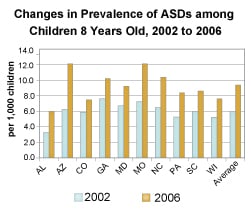CDC Statistics
Data & Statistics
On this Page
Prevalence
- It is estimated that between 1 in 80 and 1 in 240 with an average of 1 in 110 children in the United States have an ASD. [Read article]
- ASDs are reported to occur in all racial, ethnic, and socioeconomic groups, yet are on average 4 to 5 times more likely to occur in boys than in girls. However, we need more information on some less studied populations and regions around the world. [Read article]
- If 4 million children are born in the United States every year, approximately 36,500 children will eventually be diagnosed with an ASD. Assuming the prevalence rate has been constant over the past two decades, we can estimate that about 730,000 individuals between the ages of 0 to 21 have an ASD.
- Studies in Asia, Europe, and North America have identified individuals with an ASD with an approximate prevalence of 0.6% to over 1%. A recent study in South Korea reported a prevalence of 2.6%. [Data table
 ]
]  Approximately 13% of children have a developmental disability, ranging from mild disabilities such as speech and language impairments to serious developmental disabilities, such as intellectual disabilities, cerebral palsy, and autism. [Read article
Approximately 13% of children have a developmental disability, ranging from mild disabilities such as speech and language impairments to serious developmental disabilities, such as intellectual disabilities, cerebral palsy, and autism. [Read article ]
]
Learn more about prevalence of ASDs »
Learn more about the ADDM Project »
Learn more about the MADDSP Project »
Risk Factors and Characteristics
- Studies have shown that among identical twins, if one child has an ASD, then the other will be affected about 60-96% of the time. In non-identical twins, if one child has an ASD, then the other is affected about 0-24% of the time. [1]
- Parents who have a child with an ASD have a 2%–8% chance of having a second child who is also affected. [1]
- It is estimated that about 10% of children with an ASD have an identifiable genetic, neurologic or metabolic disorder, such as fragile X or Down syndrome. As we learn more about genetics, the number of children with an ASD and an identifiable genetic condition will likely increase. [Read summary
 ] [Read summary
] [Read summary ]
] - A report published by CDC in 2009, shows that 30-51% (41% on average) of the children who had an ASD also had an Intellectual Disability (intelligence quotient <=70). [Read article]
Intelligence quotient (IQ) of children aged 8 years with an autism spectrum disorder (ASD) for whom psychometric test data were available,* by site and sex (IQ) score-Autism and Developmental Disabilities Monitoring Network, 11 sites, United States, 2006
 [D]
[D]
- Studies show that 5% of people with an ASD are affected by fragile X and 10% to 15% of those with fragile X show autistic traits. [Read summary
 ]
] - One to four percent of people with ASD also have tuberous sclerosis. [Read summary
 ]
] - About 40% of children with an ASD do not talk at all. Another 25%–30% of children with autism have some words at 12 to 18 months of age and then lose them. Others may speak, but not until later in childhood. [2]
Diagnosis
- The median age of earliest ASD diagnosis is between 4.5 and 5.5 years, but for 51–91 percent of children with an ASD, developmental concerns had been recorded before three years of age. [Read article]
- Studies have shown that about one third of parents of children with an ASD noticed a problem before their child’s first birthday, and 80% saw problems by 24 months. [Read summary
 ]
]
- Research has shown that a diagnosis of autism at age 2 can be reliable, valid, and stable. [1] But despite evidence that ASDs can often be identified at around 18 months, many children do not receive final diagnoses until they are much older. [Read article
 ]
]
Economic Costs
- Recent studies have estimated that the lifetime cost to care for an individual with an ASD is $3.2 million. [Read article
 ]
] - Individuals with an ASD had average medical expenditures that exceeded those without an ASD by $4,110–$6,200 per year. On average, medical expenditures for individuals with an ASD were 4.1–6.2 times greater than for those without an ASD. Differences in median expenditures ranged from $2,240 to $3,360 per year with median expenditures 8.4–9.5 times greater. [Read summary
 ]
]
References
No comments:
Post a Comment